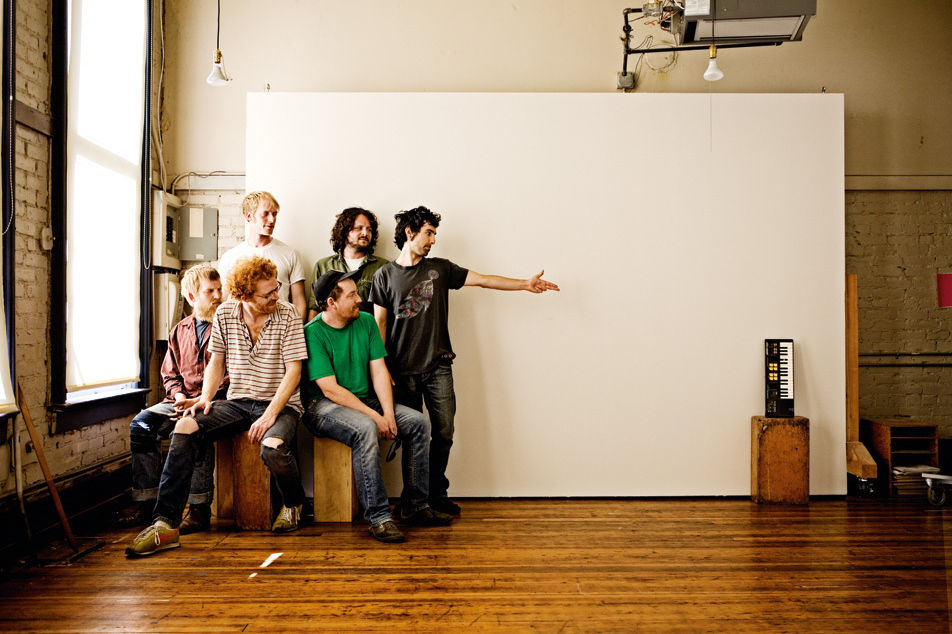
Meet Your Makers
THE UNDERDOG
Corey Lunn, Visual Artist
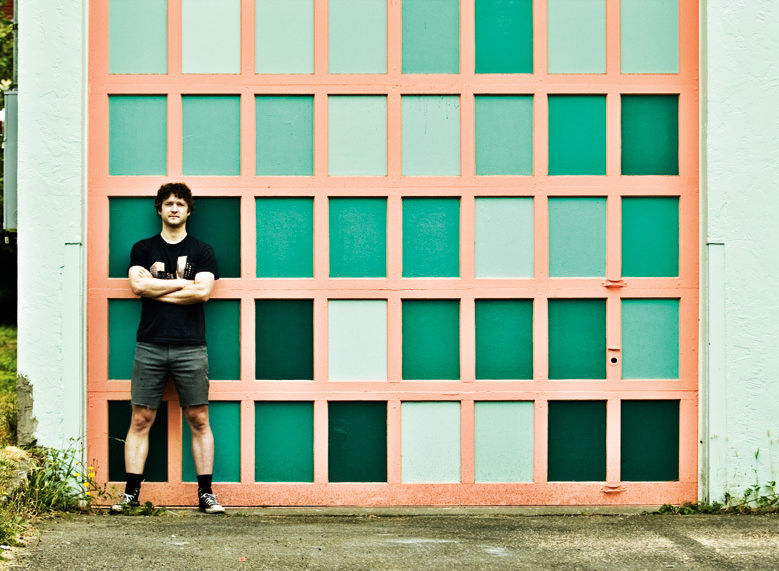
Image: Adam Levey
Inside a tiny brick workspace off SE Belmont Street littered with snowdrifts of shaved foam, Corey Lunn presses his back rigidly against a cement wall and eyes the rolling tape recorder like it’s a coiled rattlesnake. “I’ve never been interviewed before,” he says quietly. “This is weird.” But this is what happens when your first major solo exhibition is also one of the most anticipated shows of the Time-Based Art (TBA) Festival, an annual event put on by the Portland Institute for Contemporary Art (PICA). The 32-year-old has been creating art—whether intricate drawings or hand-carved sculptures—for a decade, but until recently not many people outside the innermost of the city’s art circles much cared. Now, though, thanks to consistent prodding by Kristan Kennedy, PICA’s visual-art program director, Lunn is finally offering his work to a larger audience—in this case, at least a few thousand of the expected 20,000 or so festival attendees. He’s still grappling with the ramifications of the decision.
“Some artists are resistant to institutionalized artwork,” says Lunn, whose show opens September 4 at the Works at Leftbank. “But I’m very grateful for this. Still, the attention is definitely uncomfortable.”
It’s also warranted. Combining elements of pop fantasy with what Lunn calls his “obsession with the post-apocalypse,” the objects taking shape in his workshop (most made out of high-density urethane board) are flint to the imagination: part Where the Wild Things Are, part The Road Warrior. The slightly ghoulish torso of a character he calls “The Henchman” sits on one end of his workbench; next to him is another, hairier trunk whose face has yet to be chiseled. At the edge of the table, the shell of an ATM stands ready to give way to Lunn’s symbolism—he’s looking for a sleeping bag large enough to entomb it in.
“They’ve become these sort-of social watering holes,” Lunn explains, pointing to the cash machine. “We’re tied to them. I just wish [my account] wasn’t always so empty.” Like his anonymity, the moniker of “starving artist” is something Lunn may soon be leaving behind.—Bart Blasengame
THE PROVOCATEURS
Teeth, Dance
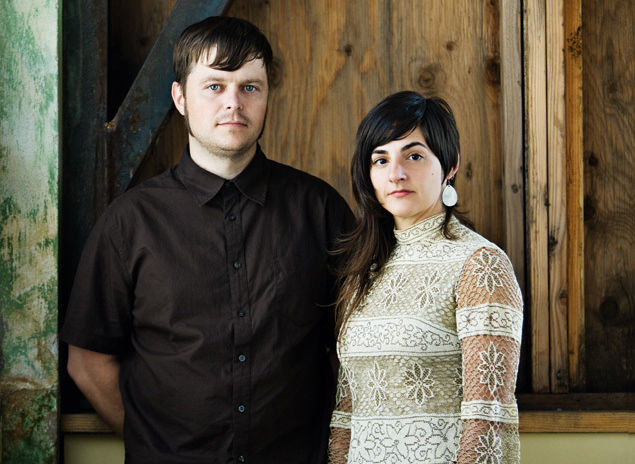
Image: Adam Levey
In a sweltering room above a furniture-consignment shop, a man is screaming. And laughing maniacally. A mass of broken bodies writhes at his feet. The bodies clutch at his arms and legs as the grinding pulse of synthesizer music fades, until all one hears is the thud of knees and knuckles slamming against particleboard flooring. The scene is befitting a Saw film, but this macabre circus is, in fact, just another rehearsal for local dance ensemble Teeth, whose latest brilliantly salacious choreography, Grub, hits the Interstate Firehouse Cultural Center November 13 to 15. Founded in 2006, Teeth unapologetically stretches the very definition of what many of us might call dance—not to mention the boundaries of avant-garde art forms, or even good taste (not everyone takes kindly to disembodied deer heads). But leave it to Teeth—whose name is an homage to the many years of dental surgery and trauma endured by Angelle Hebert, the company’s co-director and choreographer—to thumb its nose at boundaries.
“We usually have at least a couple people walk out of every show,” says Teeth co-director and composer Phillip Kraft. He could be referring to a recent performance of Benumbed, in which a cast dressed in crudely stitched canvas and metal appeared to devour a fellow dancer like a pack of rabid dogs. Not that the ick factor seems to bother Kraft, or Hebert, his wife. Their first performance, Rash, featured just the two of them, and revolved around a drenched and contorted Hebert pulling and prying painfully at her own mouth. Although the company has grown to six dancers for its performance this fall, the promotional photos for Grub, which feature nearly naked dancers wallowing in the mud of a pig trough alongside a real live swine, reveal that the masterminds behind Teeth are just as twisted as ever. —Martha Calhoon
THE MULTITASKER
Amy Palomino, Actress

Image: Adam Levey
Dressed in blue sweats and perched at a table at the Portland Center Stage (PCS) Café, Amy Palomino furrows her brow as she pores over notes to the score for the theater’s upcoming production of Guys and Dolls, which opens September 23. What she really seems to need, though, is a map. A compact, remarkably animated woman, Palomino gestures with her hands as she recounts the many entrances and exits in store for her this fall: four dancing parts; a half-dozen costume changes; understudy work for one of the leads, Adelaide. Then there’s her role as company dance captain. Palomino looks up from her notes. “I’m wearing a million hats.” She pauses. “OK, maybe four.” A million or four, it doesn’t matter: She’s the most versatile actress/dancer/manager/singer currently working the Portland stages.
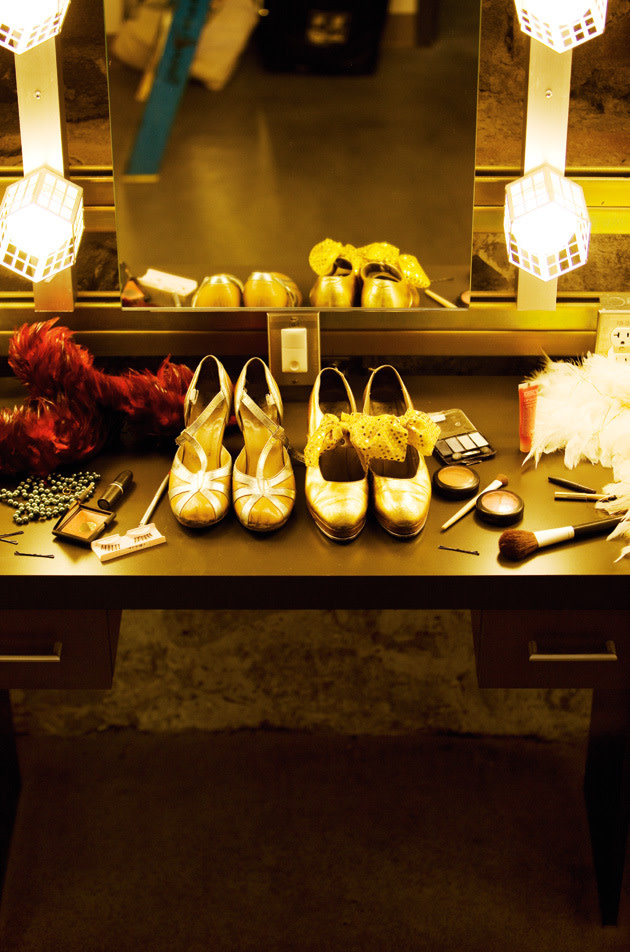
Image: Adam Levey
Since her arrival three years ago from New York City, the 29-year-old’s schedule could only be described as hectic. Her first role was playing the tomboy Anybodys in a 2006 production of West Side Story. She followed that with a Drammy Award for her lead role in 42nd Street. She’s also choreographed, acted, and danced with Lakewood Theatre, Blue Monkey Theatre, and Portland Opera. Funny, then, that her original reason for moving to town was to slow her pace after two years running herself ragged on Broadway. “I kept dreaming of a place where I could have a dog,” she says. “And where I could visit a neighbor and come in for coffee.” Palomino does get her coffee; it’s just that it’s nearly always in a to-go cup. —John Chandler
THE INSTIGATOR
Mike Shiley, Filmmaker

Image: Adam Levey
“I’m the most successful filmmaker in Oregon,” Mike Shiley says, running a hand over his close-cropped head of gray hair. “I’ve made a million dollars off three films. Gus Van Sant is successful, too, but he’s a Hollywood director who just happens to live here.” In just three sentences, Shiley, a documentarian with equal parts guts and guile, has managed to both take down one of Portland’s most sacred cows and question what exactly constitutes a homegrown artist. These are interesting points, and they’re delivered with bravado—exactly the kind of headfirst approach Shiley uses in his films. Whether he’s sneaking into a war zone with a fake press pass to slog through the desert alongside U.S. soldiers for Inside Iraq (2004)—the jacket he wore while embedded with the American troops is pictured above—or wading through the streets of New Orleans with an animal rescue team after Hurricane Katrina in Dark Water Rising (2006), Shiley’s identity as troublemaker and truth-teller is always on display.
His latest film, Solving Immigration, out this fall, is the 41-year-old’s risky foray to the front lines of a hot-button topic. Shiley spent one grueling month roaming between San Diego and Tijuana, exploring both sides of the immigration issue: the volunteer border guards who make up the Minutemen on the American side; a Catholic relief organization on the Mexican side. “I wanted to talk to the amateurs,” Shiley says, “the people who are the most passionately committed to this cause.”
Like Shiley’s other films, Solving Immigration came with a high level of personal risk. “The business of getting illegals into the U.S. is controlled by the Mexican mafia,” he says, seeming to revel in the danger. “Those guys wouldn’t think twice about taking some gringo with a camera out into the desert and making him disappear.” As he says this, there might as well be a smile on his face. —JC
THE ECLECTICISTS
Blitzen Trapper, Band
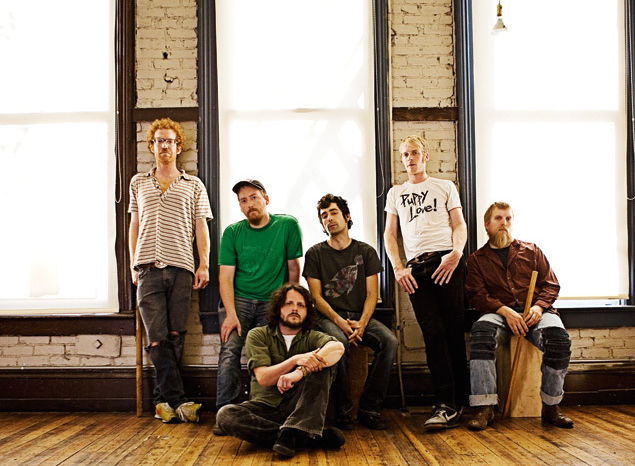
Image: Adam Levey
Eric Earley, Blitzen Trapper’s chief songwriter and singer, is somewhere in Washington state, tucked cozily inside a van that’s zooming up I-5. The trees lining the side of the road are green. The traffic is light for a change. It’s a good day. But his cell phone has started breaking our conversation into bits. Given the situation, it’s best to be brief.
“I think the new record was influenced by—” he says, trailing off. “I don’t know—whoever.” These might sound like the detached musings of an aspiring rock star, if not for the fact that such haziness perfectly describes what the band does best—that is, everything. Over the course of a typical album, sometimes even over the course of one song, Blitzen Trapper revels veers between folk-country, power pop, hippie hootenanny, and fuzzy guitar freak-out. But the band’s fourth album, Furr (out September 23 on Sub Pop), features something that is, at least for these musicians, truly revolutionary: focus. A newfound attention to sugary hooks makes Furr one of the best rock albums of 2008 (just try to keep from falling in love with the sing-along lilt of the title track).
Luckily, despite the band’s sudden notoriety in indie rock’s upper echelon, Blitzen Trapper hasn’t ditched Portland. Like Wild Mountain Nation, the group’s last album, Furr was hashed out in a studio in a battered telegraph building near the Willamette River that used to house Sally Mack’s School of Dance. This time, though, the band added a piano that Earley found abandoned in the hall of the building. It’s missing a few keys, but no matter: The instrument lends a mournful sigh to new tracks like “Not Your Lover” and “Echo.” Like many Blitzen songs, “Echo” proceeds to bleed from lo-fi piano ballad to ambient dirge to funky breakdown in the course of three minutes. Some habits, apparently, die hard. “We’re not ADD,” Earley insists.
“I just don’t like to do the same thing twice.” —JC
THE TASTEMAKER
Charles A. Hartman, Hartman Fine Art

Image: Adam Levey
Hunched over a concave wooden table lodged between two wall-size photographs—one depicting Cairo as a bustling desert cityscape, the other fixated on its Bedouin origins—Charles Hartman is trying to explain the gravity of his job.
“To me, art is one of the few things you buy and own forever,” the 38-year-old gallerist says, laboring intently over each word. “Over time, the object doesn’t change, but your perception of the object changes—it’s a powerful thought.”
He pauses. “Wait. That sounds cheesy, doesn’t it?”
Not really. In fact, while some gallerists are either shameless promoters or struggling scenesters, Hartman’s even-keeled, almost sedate confidence is subtly engaging, deftly straddling the line between salesman and trusted connoisseur. It might explain why the seven vintage Ansel Adams photographs of various winter landscapes are hanging in the stairwell leading to his office: They aren’t positioned to sell, but they certainly look good.
“I need to eat,” Hartman explains, pointing to the glass frames filled with seasonal black-and-white scenery, “but I’m not a raging capitalist.”
The bulk of the work shown and sold at Hartman Fine Art, located at 134 NW Eighth Ave, are photographs that concentrate on the world outside of Portland: from historically significant photographs by Edward Weston and Aaron Siskind to provocative, claustrophobic nudes by Tokyo-based Emi Anrakuji. Hartman’s unique ability to show and move such sought-after pieces (which are priced from $800 to more than $15,000) is thanks largely to his thick Rolodex.
“If somebody walks in and wants an Elliott Erwitt, I can get it for them with a couple of calls,” Hartman says. “Same thing if somebody comes in looking for something hard to find by Ansel Adams—three or four calls. Max.”
Hartman just wrapped an exhibition of Eadweard Muybridge’s landmark motion-capture experiments from the late 1800s, and in October he’ll debut a rare nonphotography show featuring the line drawings of Los Angeles native Jessica Curtaz. This spring, he’ll deviate from his usual course even further when he dedicates his gallery to the paintings and mixed-media efforts of local artist Eva Speer. “I’m not going to show someone just because they’re local—enough galleries already do that,” he says. “To me, it’s more exciting to look at local artists against a national context.” Another pause. “That doesn’t sound too highfalutin, does it?” —BB
THE FABULIST
Willy Vlautin, Author
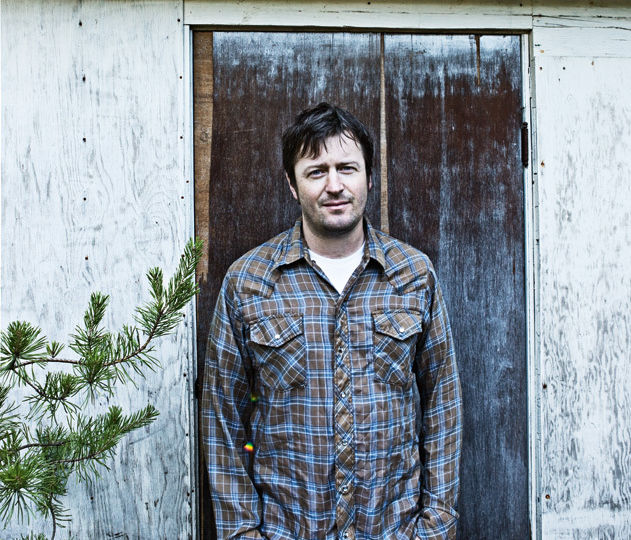
Image: Adam Levey
Every yellowing trinket and scrap of paper crammed inside the battered wooden writing space that Willy Vlautin calls “The Shed” is a beloved piece of his personal history: from the racks of battered vinyl and the memorable quotes from authors like William Kennedy or John Steinbeck stuck on the wall, to inspirational photos of drunken troubadour Shane McGowan and ill-fated starlet Carol Lombard. But the most impressive bit of archaeology is the glittering marquee that once hung above the Last Dollar, Vlautin’s favorite—but now defunct—watering hole in his hometown of Reno, Nevada. All it took to acquire was a 12-pack of beer, offered in trade to a Reno bartender who wanted the sign taken off his hands. Of course, the gin-slinger experienced a little barterer’s remorse soon after. “I said I’d leave it to him in my will,” Vlautin says. “So if anything fishy happens to me, you know who’s responsible.”
The desert in general, and the seedy folks who live there in particular, have played major roles in each of Vlautin’s novels, The Motel Life and Northline, both of which have elicited rave reviews from the New York Times and the Washington Post , have become best sellers, and have been optioned for films. It’s an effectively bleak playground for his characters—normal folks knuckled under by hard times. But, although the 40-year-old still pines for the fading glitz of Reno, from a literary standpoint he’s moving on.
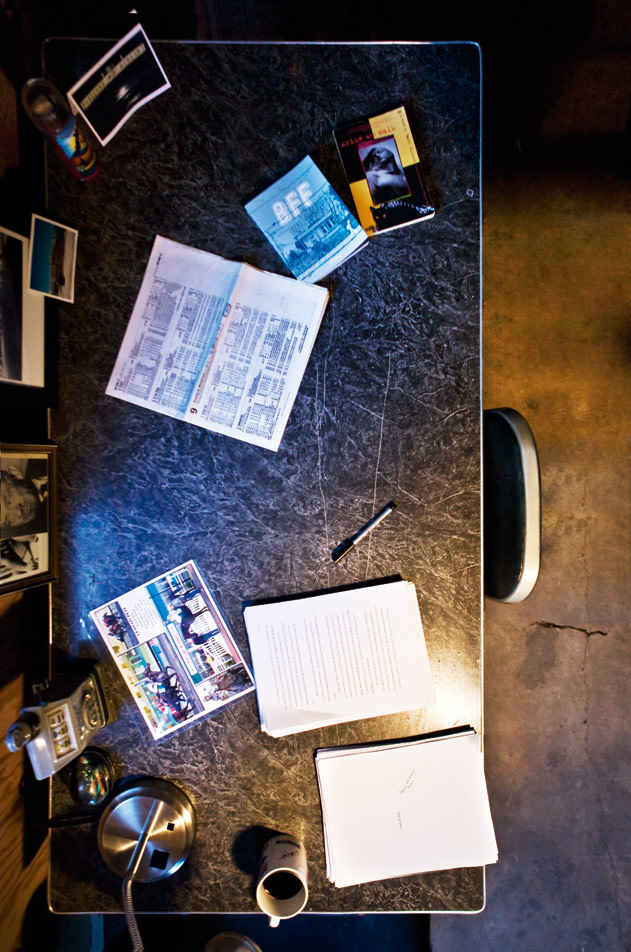
Image: Adam Levey
The manuscript currently sitting on his desk chooses the green grass oval and churned sod of Portland Meadows as its backdrop instead. It’s called Lean On Pete, about a kid who ends up living at the weathered North Portland racetrack, one of Vlautin’s favorite hangouts and creative-rut-busting spots.
“I wanted to name the book after a Meadows horse,” says Vlautin, who will preview his new work in November as part of Portland’s Wordstock literature festival. “I went down when Pete was racing. I thought, If he wins I’ll name the book after him.” Pete won, and after Vlautin tried and failed to jump into the winner’s circle photo, the horse’s owner expressed mock concern about the author’s choice of inspiration. “He said, ‘You can’t tell if that horse is gonna run or be a piece of shit,’” Vlautin says, “which I thought was a perfect description of the book.” —BB




